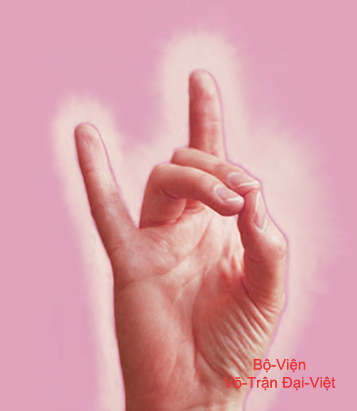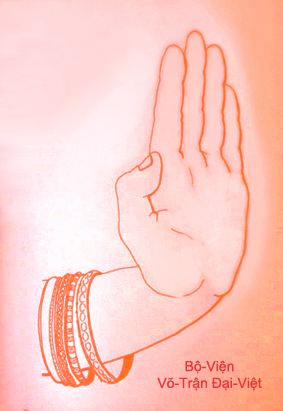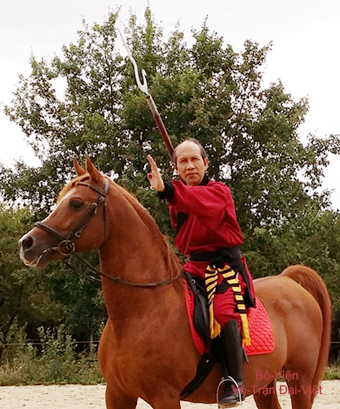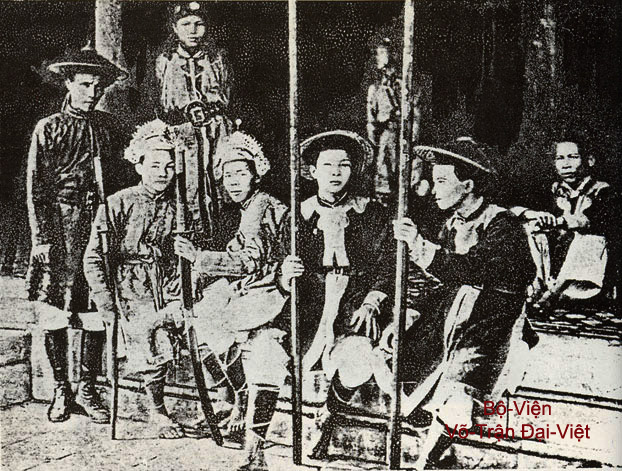THE WAY OF SWORD AND BOW
FROM ĐẠI-VIỆT
The Way of the Sword from Đại-Việt
Kiếm-Đạo Đại-Việt
大越劍道
Beyond the using in war, Sword is still used as emblematic symbols :
1) - Emblematic Symbol of power in the nation ; it is there « the Precious Swoerd of du Supreme Power - Phương Thượng Bảo Kiếm » (芳 上 寶 劍 ) that the Soveraign offers to a grand mandarin of the court for confering on him the right « To Beheading before and To Making report after - Tiền Trảm Hậu Tấu ».
2) - Emblematic Symbol of Dignity at the Court ; it is there the Sword with his Scabbard, whom ornementation and inscrutation of precious stones as well as gold and silver differ according to the nobiliary hierarchy.
3) - Emblematic Symbol in the Society ; it is there the Sword of great famillies of Letters.
4) - Emblematic Symbol of Mystic Power in the Magic ; it is there the Sword of Taoists having the power to eliminating Phantoms and to killing Devils, to making oneself invisible, to beheading at a distance.

The Sword of Wisdom (Shes Rabralgri).
- Vajrayana Bouddhism - Inde -
(Photo Credit : exoticindiaart.com)
It's precisely these Symbols aforementioned which lead the user of Sword - « the Sword Man - Kiếm-Sĩ » - right into the domain of the « Spiritual Conscience » in order to live the experience from the concept of the Way of Sword - Kiếm-Đạo.
So thus, Martial Student of Đại-Việt Sword Wielding Method (Kiếm-Pháp 劍 法) needs to be teached by a person being already trained for the Three Jewels "Seminal Essence Energy Tinh - Breath Energy Khí - Spirit Energy Thần" Concentration Method in first time in order to be enlightened on the notion about the Breath Energy of the Sword (Kiếm-Khí 劍 氣).
The action principle of the Sword Breath Energy (Kiếm-Khí - 劍 氣) in « the Way of Sword from Đại-Việt ».is :
« To Accumulate Breath Energy and to Condense Spirit Energy
allow the Sword Breah Energy to Fly Off ».
« Súc-tích Khí, ngưng-đọng Thần, thì Kiếm-Khí vọt bay »
(Tụ Khí Ngưng Thần Kiếm-Khí Phi - 聚 氣 凝 神 劍 氣 飛).
- « To Accumulate », means "To Assemble a lttle thing for becoming much more" that's called « Tụ 聚 To Acumulate ».
- « To Condense », means "To Concentrate a Fluid" that's called « Ngưng 凝 To Condense ».
Why is the Spirit Energy Thần considered as a "Fluid " ? - Because the Spirit Energy Thần comes from the transformation of Breath Energy Khí which is inherent in a "Fluid " ; as well as the Breath Energy Khí comes from the sublimation of Seminal Essence Energy Tinh ; but Seminal Essence Energy Tinh originates from "Renal-Liquid Thận-Thủy 腎水" which is also inherent in a "Fluid ".
As that we have said previously, the Art of Sword is inherent in the Vital-Breath KHÍ, thus the Sword wielding uses the most often the Prâna-Mûdra as Mûdra of Fencing but the Apâna-Mûdra is very rarely used.
Given that the Grand TAO mobilizes always the « Prâna » - i.e. the Pure Energy of Vital Breath - for nourrishing and looking after all beings and things in cosmic universe, in the Sword wielding exists always hiddden the part of spirituality from the Way of Sword through out the Mûdra of Breath Energy « Prâna-Mûdra » in the Fencing.
Digital Gesture « Prâna Mûdra ».
|
Digital Gesture « Apâna Mûdra ».
|
In addition, the Method of Sword Wielding from Đại-Việt using in battlefields didn't employ these two Mudra previously quoted but employed Pâtaka Mûdra, i.e. Flag Seal Kỳ-Ấn 旗 印. It is true that Old Masters as well as Fencing Master Phi-Sơn Hải, Grand-Master Phạm-Thi, Grand-Master Ba-Phong, Grand-Master Lâm Ngọc Phú, ... have been all employed regularly the « Pataka Mudra » in their Method of Sword Wielding.
This « Pâtaka Mûdra », still called the « Great Hand Seal - Maha Hasta Mûdra (Đại-Ấn Chưởng), is often used in the Wielding of Pole-Arms ( Pertuisane Mâu, Vouge Siêu-Đao, Halberd Kích... )
« Pâtaka Mûdra - Flag Seal »
|
« Pâtaka Mûdra - Kỳ-Ấn 旗 印 »,
employed in Pertuisane Wielding,
|
Under the ĐƯỜNG (TANG) Dynasty Period (618~907 AD), the art of welded Steel Swords reached a level of perfection without precedent and inequaled afterwards in Far East, and enlarged his influence into al limitrophes countries from same culture, ie. Japan, Việt-Nam, Korea and Tibet.
It took to wait untill Yoshino Period (14th century) in Japan for that comparable precious Swords could be forged again but they belonged to the Category of Curved Blade Swords, i.e. Sabres-Gươm called « Katana, easier to forge and to temper than the one of Swords with Staight Blade from TANG Dynasty.
The characteristic of Swords in TANG Dynasty consists in a Straight Blade with Single Edge owning two lateral angles (one in each side), called Tích ((脊) - Shinogi in japanese - situated near the Blade back , i.e. : far from the edge (this Blade is called in Japan by "Shinogi Zukuri"). That's why the Blade of this Sword from TANG Dynasty period is not also heavy as the one from SUY Dynasty period and becomes easier to handle.

« Long Sword » from
TANG Dynasty Period (618~907 AD)
ancestor of the JAPAN's Sword called « Shinogi Zukuri Tachi »
and the ĐẠI-VIỆT's Sword with Raised Point (Ikari no Kissaki Tsurugi).
(Photo Credit : Thomas CHEN)
Painting of « ĐẠI-VIỆT Long Sword », holding |
« ĐẠI-VIỆT Long Sword », holding |
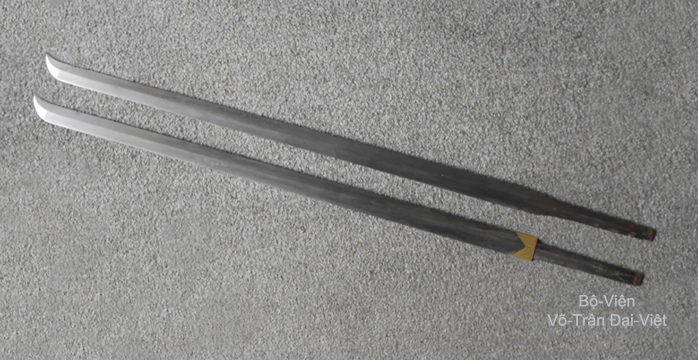
« Steel Two Matched Swords » Blades with Single Edge,
and having a Raised Pointe (Câu-Kiếm-Phong 鉤 劍 鋒),
with Ricasso in " V " shaped, specific from Đại-Việt.
(Photo Credit : Bình-Định Sa-Long-Cương France)
Later, under the ĐƯỜNG (TANG) Dynasty, another category of Sword, those of Two Edged Straight Sword was invented with an Inferior Edge (Hạ-nhận 下 刃) and a short Superior Edge (Thượng-Nhận 上 刃) or "Contre-Tranchant", located near by the point of the Sword, on the side of the back blade.

« Long Sword » with "Contre-Tranchant" from TANG Dynasty Period (618~907 AD),
ancestor of two categories of Japanese Sword called « Shinogi Zukuri Tsurugi »
and « Kissaki Moroha Zukuri Tachi - " Kogarasu Maru - 小烏丸 Tiểu Ô-Hoàn - Little Crow " ».
(Photo Credit : Thomas CHEN)
The Japanese Sword « Kissaki Moroha Zukuri Tachi - "Kogarasu Maru - 小烏丸 Tiểu Ô-Hoàn - Little Crow" » with a long Inferior Edge (Hạ-nhận 下 刃) and a short Superior Edge (Thượng-Nhận 上 刃) or "False-Edge" is a piece of evidence speaking for itself of the influence of the Sword with Straight Blade from TANG Dynasty (618~907 AD).

Japanese Long Sword (Sabre-Gươm) holding Curved Blade
« Kissaki Moroha Zukuri Tachi - "Kogarasu Maru - 小烏丸 Tiểu Ô-Hoàn - Little Crow" »
(This Sabre-Gươm having been belonged to the Emperor Kammu 781~ 806 AD).
Later, this Category of Sword with Curved Blade evolved towards the Sabre-Gươm or Sabre-Đao, holding single edge. It's provides an obvious proof of the influence of the Sword with Straight Blade from TANG Dynasty (618~907 JC). and includes two kinds, the one of Two-Handed Sabre-Gươm and the one of One-Handed Sabre-Gươm :
1) The Two-Handed Sabre-Gươm :
It's the Sword with a Curved Blade (called Katana), that Japaneses have raised into the highest degree of perfection in the forge of Sword, comparable to the one from TANG Dynasty Period (618~907 JC).

Japanese Two-Handed « Sabre-Katana ».
YOSHINO Period - 14th century.
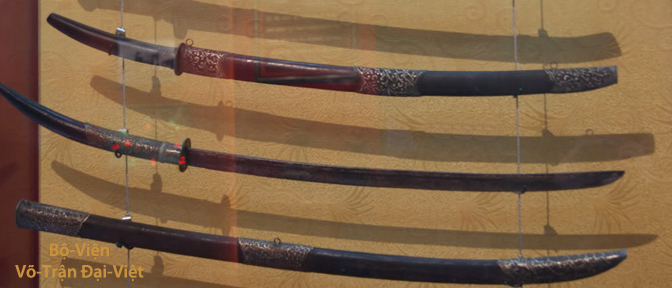
Two-Handed « Sabre-Gươm » of ĐẠI-VIỆT
Circa 18th~19th centuries.
( Photo credit : Nguyễn Ngọc Phưong-Đông )

Two-Handed « Sabre-Gươm » of ĐẠI-VIỆT
Circa 18th~19th centuries.
Imperial Guard holding the « Two-Handed Sabre-Gươm »
NGUYỄN Dynasty (1802-1945)
( Photo credit : Nguyễn Khắc Ngữ )
2) The One-Handed Sabre-Gươm :
It's the Sword with a Curved Blade the most usual in the world, and it's still called « Đao » in China and « Sabre » in Europe.
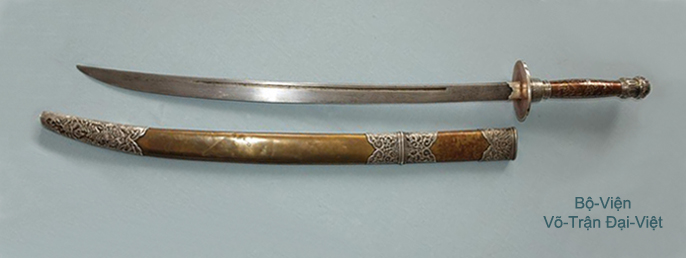
« One-Handed Sabre-Gươm » of ĐẠI-VIỆT
Đại-Việt - Circa 18th~19th centuries
(Photo Credit : Gavin Nugent, swordsantiqueweapons.com)

« One-Handed Sabre-Gươm » of ĐẠI-VIỆT
with an Inferior Edge (Hạ-nhận 下 刃) and a short Superior Edge (Thượng-Nhận 上 刃) or "Contre-Tranchant",
located near by the point of the Sword, on the side of the back blade.
Đại-Việt - Circa 18th~19th centuries
Material Considerations
The Đại-Việt Fencing, like Traditional Martial Arts of Bình-Định moreover, it's based on the « elimination of proxility principle in the name of expurgation » (khứ vu tồn thanh) and on the « Deletion of the Complication principle in the name of Realization of SImplicity » (San Phồn Tựu Giản).
It was forged by the Ancients on battlefields, in order for fighting the numerical superiority, acccording to the Martial Principle of « to use that is short for defeating that is long - to use that is is Soft for dominating that is Hard ».
Therefore, the Traditional Fencing from Bình-Định (Việt-Nam) calls for only 12 ways of Sword wielding :
| 01. To Thrust - Đâm - (Thích 刺) 02. To Cut - Chém - (Khảm 砍), 03. To Slash - Vót - (Mạc 莫), 04. To Peel - Gọt - (Tước 削), (𠞡), 05. To File down - Giủa - (Thác 錯), 06. To Smooth - Vuốt - (Loát 捋). 07. To Escape - Thoát - (Thoát 脫), 08. To Raise - Nâng - (Đề提), 09. To Press - Đè - (Bằng 憑), 10. To Wrap - Bọc - (Bao 包), 11. To Overturn - Lật - (Đảo 倒), 12. To Drown - Dìm - (Trầm 湛). |
With these 12 ways of Sword wielding quoted previously as well as their spécific application's way from Battlefields Martial Arts of Vietnameses, with a view to Defeating the Speed by the Slowness according to the Martial Principle of « to control the Disturbance by means of the Serenity », thus the Art of Sword from Đại-Việt cristallizes « Waiting Sword - Trạm-Kiếm - 站 劍 » and « Nonstop Sword - Hành-Kiếm - 行 劍 » in only one Art of Sword, that's the « Sword in Action - Tác-Dụng Kiếm - 作 用 劍 ».
(To be continued...)
VÕ-TRẬN-ĐẠI-VIỆT |
Return to Page HISTORY |
Return to Page DISCUSSION |
|---|
Copyright © 2004 - 2018 by ACFDV - All rights reserved.

